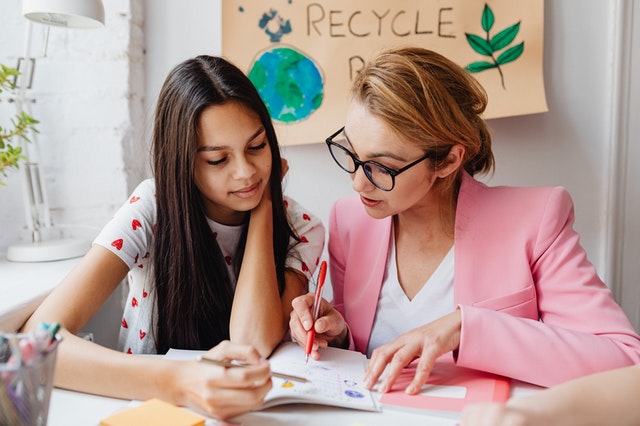Teachers all know the stereotypes about older students’ negative attitudes in school. They’re surly, unmotivated to try new things, and sometimes even depressed. Younger students tend to be significantly more upbeat, and even excited to come to class and learn new things. Even when things go wrong, younger students tend to be more resilient to bounce back and forget a bad day.
While these stereotypes paint all teens with a broad brush and some are still bright, energized, and happy to try new things, recent research explains why so many young adults struggle to stay positive, especially in a challenging environment. Surprisingly, the research shows that it isn’t teens who are overly negative, but younger students that are “hyper optimistic” when it comes to schooling.
New Research on Older Students’ Negativity
The research on students’ negative attitudes was conducted by lead investigator Dr. Tobias Hauser, lead author Johanna Habict and their team from the Max Planck UCL Centre for Computational Psychiatry & Ageing Research and Wellcome Centre for Human Neuroimaging and UCL Queen Square Institute of Neurology. Dr. Hauser designed a game to measure young people’s approaches to learning and assess something called their “optimism bias”.
Optimism bias is defined as the overestimation of outcomes of one’s performance on a task before completing it. While all participants across all age groups had some amount of optimism bias, thinking that they would score higher than they actually did, the researchers found that this optimism bias reduced as the person aged.
The study participants were in three age groups, firstly children aged 8-9, then children aged 12-13, and finally children aged 17-18. While there was evidence of an optimism bias in all three groups, there was a clear trend that showed that the younger the students were, the more likely they were to have a higher optimism bias.
According to the researchers, the younger students’ optimism “was driven by a reduced learning from worse-than-expected outcomes, and this reduced learning explains why children are hyperoptimistic.” (Habicht et al.) So rather than older students losing some capacity to overcome negativity, these results suggest that this newfound negativity is the result of the development of more mature learning pathways that help them to focus on and learn more from negative experiences.
The researchers suggested that this lowered focus on negative outcomes in youth is actually an adaptive feature of evolution that helps children to not lose motivation as they learn and develop. “Our findings thus show that insensitivity to bad outcomes in childhood helps to prevent taking on an overly realistic perspective and maintain motivation.” (Habicht et al.) While this may be true, the research also clearly shows that this negative bias isn’t a bad thing that is “lost”, but actually the brain learning to be safer as the person gains maturity.
Because the trend was largely universal in the development of all children, this shows that the increased negativity isn’t the result of failed evolution, but instead simply children growing older and getting more realistic as they experience more adversity in life. Children and teens that don’t learn from their mistakes and continue dangerous activities even after experiencing negative outcomes will be at higher risk.
Teenagers are already known as risk takers due to their increased hormones in puberty along with a lack of experience, and so this research shows one of the ways that the brain helps young people to mature and avoid dangerous situations. It also explains why young children seem to “bounce back” so quickly from problems but teenagers tend to dwell on the negative.
This increased focus on negativity may be frustrating for adults and difficult to experience as a teenager, but it is an important stage of psychological development in place to help balance out the risk taking behavior young people have with strong feedback on which experiences to avoid in the future.
Teacher Takeaways

Younger students’ high energy may be a lot to handle day after day, but their positivity and excitement are often infectious for the teacher. One of the difficulties of teaching older students is that though they generally take less energy to corral and are more independent in doing activities, their negative attitudes can be draining on a teacher and lead to a negative classroom environment.
The trade off for independence is often that the teacher has to do a lot more to motivate and excite their students about learning. It can seem impossible to break past this negativity barrier in older students, but there are ways that teachers can utilize the knowledge from this study to make things a little easier for themselves and keep students from falling too far into pits of despair.
The first thing that teachers should take to heart is that this negativity isn’t just a result of the modern world, students’ lowered resilience, or a problem with their teaching style. Instead, teachers should see this negativity as natural and work to find ways to naturally reduce the fear of negative outcomes. There are several ways to do this without reducing challenge or resorting to bribing students to do work by trying to switch to positive motivators.
Positive motivators can be beneficial to get students to do work, but can often lead to reliance on these external motivations in order to want to do anything. Teachers who often give out rewards or treats for good work will often find their students asking about the rewards, points, or treats they are to receive before being willing to start and being even less motivated when the teacher doesn’t always provide their expected bribe.
Instead, teachers should work to make negative outcomes less worrying for students. Firstly, this can be done by allowing more retakes on tests, rewrites of papers, and redos of projects.
While this initially might seem like a way to lower student challenge by simply allowing them to redo work late if they don’t prepare adequately, this approach not only lowers the risk of poor performance on examinations but also encourages students to actually do more work on their own volition. The purpose of tests and papers isn’t to punish students who are late and behind, but instead to encourage and show learning they have gained through coursework.
Tests are teaching tools, and if students actively want to do more work by studying for and taking a test again, this should be encouraged! Students wanting to spend more time improving their grades should be encouraged to do so whether that means polishing off mistakes in their writing, taking another stab at a test, or redoing a project.
This works to increase motivation by lowering the risk of possible negative outcomes while actively encouraging students to spend more time with coursework and see that their efforts can actually lead to improved grades. This is also a great way to increase students’ contact time with course materials in addition to fighting students’ negative attitudes towards school and testing.
Another way that older students’ negative attitudes seep into the classroom is by poor performance being seen in a bad light socially. In addition to how bad grades can be seen as an indelible black mark on their permanent record for a class if retakes aren’t allowed, students also often feel judged by peers or even the teacher when they do poorly in class.
Teachers should work to reframe mistakes, failures, and poor performance as simply a step towards success rather than a sign that someone is doing a bad job. Teachers should have lectures where they highlight their own personal weaknesses and failures and show how those failures didn’t stop them from achieving their goals, and in fact were critical steps in learning how to be successful later on.
The stereotypical example here is to discuss how many failed attempts inventors like Thomas Edison had to go through before their invention actually worked. If inventors gave up at their first failed prototype, they would never be able to develop their successful variants later on. Similarly, students need to see failures as totally fine and expected in any challenge. Students could have a whole project on looking at something they had to fail at multiple times in order to do well. Whether students like video games, sports, or art, they often experience “failures” before actually achieving success.
Players of video games often start off very unskilled and have to “die” or get “game over” many times before being considered good players at a given game. Having a gamer look at their profile records in their favorite game or monitor their progress in a new game and document their performance will help them see how their mistakes actually led them to developing ways around their issues in the game. No child expects to win a video game without losing a single time and in fact, many gamers would be disappointed in a game that provides so little challenge.
If the students aren’t gamers, there are still many other ways they can look into how doing poorly is an important step to doing well. Sports and art are other easy avenues for students to see how mistakes are a natural part of learning any skill. Sports enthusiasts can either document their own abilities and mistakes or look into professional players’ journeys. While many athletes have always had a natural talent for their sport, that doesn’t mean they never make mistakes, and any professional athlete will have areas of weakness that they had to develop in order to be competitive.
Artists follow a very similar trajectory as gamers and sports players. As a recent online trend, artists will often post their art from years ago next to a recent project to compare and show how much progress they have made in their years of work. Rather than that poor piece of art being seen as a mark of shame, it is highlighted through contrast to show that time and practice have helped them to develop their craft. If they had never drawn that first art piece, regardless of how poor it may have been, they would never have been able to develop the techniques required to create the higher level art.
Whether in grades, art, or any other activity, helping students to look at how success isn’t instant and poor performance is actually normal will help them to be less negative about poor performance. While students will still feel bad when they do poorly, this also is natural and not something to shame students for.
Rather than seeing this negativity as something bad and a sign of weakness, teachers should try to see the hidden positive aspects of students’ negative attitudes. When students are upset about a bad performance on a test or paper, this should be a sign to the teacher that the student actually cares about how they do in their class.
Rather than telling students that they should have studied more or tried harder, teachers should actually thank students who get upset over bad grades. When a student receives a bad grade, they already know they should have done more. The teacher highlighting the negative grade further by getting upset or saying “I told you so” will just make the student reinforce these negative outcomes more and can lead to them completely disengaging and no longer caring about bad grades because they are simply used to them and expect them.
But why should a teacher say thank you to a student who is upset about doing poorly? This approach may seem unorthodox and strange, but that is part of its hidden benefit. Telling a student that the teacher actually appreciates how much the student cares about their grades and performance helps them to see that the teacher is not angry, and always elicits a surprised smile from upset students.

Following up this appreciation for their dissatisfaction in their grades with an opportunity to improve that grade helps students to feel that they have control over their education and lower the fear of negative outcomes. Students that are allowed to redo and see their poor work simply as a step to high performance will be more likely to be creative and even take creative risks.
If they still aren’t willing to put in the effort, this can at least be used as a point of discussion to show them that their education is in their hands and that the teacher is giving them every opportunity to be successful. Teachers shouldn’t expect students’ negative attitudes to simply disappear with these approaches, but it will reduce the severity of the negativity and encourage more students to keep their chin up when things get tough.
This approach is especially effective in the humanities where there often isn’t a clear right and wrong in students’ answers. Oftentimes students, especially highly able students, will simply take the safest option when it comes to interpretation and structure of their work in order to not risk points. This can lead to a stifling of creativity as students fear a bad grade and decide it isn’t worth it to branch out and try something new or creative.
Lowering the negative consequences of bad grades will allow students to take more fun and interesting risks when writing or doing projects because, worst comes to worst, they can simply redo it the safe way later on and get the good grade they desire. However, when students don’t have to fear each grade as a permanent black mark on their records, they are more likely to not only have a positive attitude, but also feel more in control of their learning and see the benefits of trying, failing, and trying again.
Want more like this? Make Lab to Class a part of your weekly professional development schedule by subscribing to updates below.
References
Habicht, Johanna, et al. “Children Are Full of Optimism, but Those Rose-Tinted Glasses Are Fading – Reduced Learning from Negative Outcomes Drives Hyperoptimism in Children.” 2021, https://doi.org/10.1101/2021.06.29.450349.




